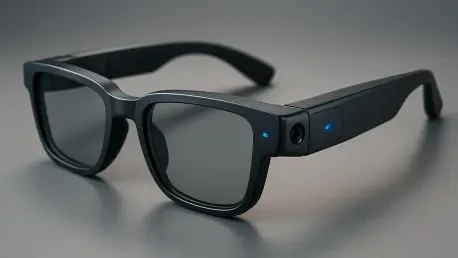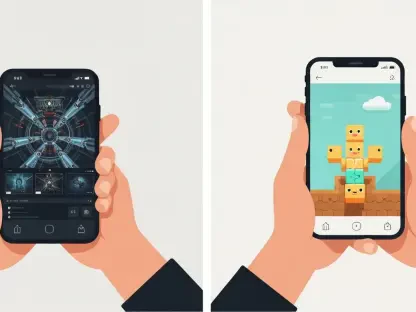Imagine stepping into a bustling city street, where your glasses not only sharpen your vision but also translate foreign signs in real time, point out the nearest coffee shop with a subtle overlay, and even identify the species of a tree you pass by. AI smart glasses have leaped from the realm of science fiction into tangible reality, evolving from the clunky and much-maligned Google Glass of over a decade ago to sleek, stylish designs like Ray-Ban Meta and Snap Inc.’s Spectacles. These devices promise a seamless integration of digital assistance into daily life, offering a hands-free way to interact with technology. Yet, as this innovation accelerates, it brings with it a host of questions that go beyond mere functionality. Are people ready to adopt such an intimate merger of tech and personal space, where digital information is literally in front of their eyes? The journey of smart glasses is one of impressive transformation, but challenges like privacy concerns, social acceptance, and practical usability remain significant barriers. This exploration delves into the cutting-edge world of AI smart glasses, examining whether they truly represent a future society is eager to embrace or one that might be met with hesitation.
Unveiling Cutting-Edge Innovations
The technological prowess of AI smart glasses is nothing short of remarkable, transforming how individuals engage with their surroundings through features that feel almost futuristic. Devices like Ray-Ban Meta offer real-time language translation, navigation aids that guide users through unfamiliar terrain, and object recognition that can name items or landmarks on the spot. Meanwhile, Snap Inc. is pushing boundaries with its next-generation Spectacles, set to deepen AI integration by allowing users to query their environment—think asking about the historical significance of a building just by glancing at it. Powering these advancements are innovations like Qualcomm’s Snapdragon AR1 Gen 1 chip, which ensures sharper displays and efficient performance without draining battery life too quickly. Beyond consumer applications, niche developments are emerging, such as Emteq Labs’ work on tracking emotional responses through facial expressions, hinting at health and wellness potential. This rapid progress underscores a shift toward invisible computing, where technology blends into the background, enhancing life without the constant need for handheld screens or overt gadgets.
Equally impressive is the scope of what these glasses aim to achieve in bridging digital and physical worlds, a concept often termed “heads-up” computing. The goal is to keep users present in their environment while still accessing critical digital insights, a balance that traditional devices like smartphones often disrupt. Startups and tech giants alike are exploring varied use cases, from EssilorLuxottica’s Nuance Audio Glasses aiding hearing in noisy settings to cinematic AR experiences that could redefine entertainment. The momentum is clear—companies are investing heavily, with platforms like Google’s Android XR slated for release in 2026, promising to refine these devices into polished consumer products. Yet, for all the technological marvels, the question lingers whether such constant connectivity aligns with societal needs or if it risks overwhelming users with information they didn’t ask for. The capabilities are undeniable, but their relevance to everyday life remains a topic of debate among potential adopters.
Blending Style with Substance
One of the most significant lessons from the early days of smart glasses was the critical role of design in gaining public acceptance, a factor that has since spurred a dramatic aesthetic evolution. Unlike the awkward, tech-heavy look of the original Google Glass, today’s iterations are crafted to resemble fashionable eyewear, thanks to collaborations with established brands like Ray-Ban and EssilorLuxottica. These partnerships have resulted in customizable options, from frame styles to lens tints and even prescription compatibility, ensuring that users don’t feel like they’re wearing a gadget but rather a trendy accessory. The shift toward style is not just superficial—it’s a strategic move to erase the “tech nerd” stigma and make smart glasses a natural part of personal expression. If these devices are to achieve widespread adoption, they must first succeed as items people want to be seen in, blending seamlessly into daily wardrobes without drawing unwanted attention.
Further elevating this trend is the involvement of luxury fashion conglomerates like Kering Eyewear, which represents high-end brands such as Gucci and Saint Laurent, now partnering with tech platforms like Google’s Android XR. This fusion of fashion and function signals a pivotal change in how wearable tech is perceived, positioning smart glasses as status symbols rather than mere tools. Industry experts argue that for mass acceptance, the aesthetic appeal must match or even surpass the technological allure, ensuring users feel confident rather than self-conscious. Meta’s substantial investment, including a $3.5 billion stake in EssilorLuxottica, reflects a long-term commitment to marrying style with innovation. However, even with these advancements, the challenge remains in catering to diverse tastes and ensuring that design doesn’t compromise comfort or practicality for the sake of looks alone.
Navigating Privacy Minefields
Despite the excitement surrounding smart glasses, a dark cloud of privacy concerns looms large, casting doubt on their societal fit. With built-in cameras and recording capabilities, these devices raise serious questions about surveillance and consent—how can anyone be sure they’re not being recorded in a world where tech is so discreet? The potential for ubiquitous data capture, often without clear indicators of when a device is active, fuels unease among the public. This isn’t just a theoretical worry; it’s a tangible barrier to trust, as people grapple with the idea of invisible technology that could be watching or listening at any moment. Manufacturers face the daunting task of addressing these fears through transparency, robust user controls, and clear policies on data usage, lest they risk alienating a significant portion of their target audience who prioritize personal boundaries over digital convenience.
Beyond individual concerns, there’s a broader societal implication to consider when technology becomes so integrated into personal space that it blurs the line between public and private. The lack of visible cues—unlike a smartphone camera that’s obvious when pointed—makes smart glasses particularly unsettling in social settings like cafes or public transport. Historical precedents, such as backlash against early wearable tech for similar reasons, suggest that without proactive measures, adoption could stall. Companies must not only innovate technically but also ethically, ensuring that privacy safeguards are as cutting-edge as the features themselves. If trust isn’t established, the most advanced smart glasses risk being relegated to niche markets rather than achieving the mainstream status that tech giants envision. Addressing this issue is not just a technical challenge but a cultural imperative that could define the trajectory of this technology.
Wrestling with Constant Connectivity
A subtler but equally profound tension exists in the promise of smart glasses to liberate users from traditional screens while simultaneously binding them tighter to the digital realm. The core appeal is the idea of freeing hands and eyes from phones, integrating tech so seamlessly that it feels like a natural extension of sight. Yet, this very integration means disconnection becomes nearly impossible—unlike a device that can be left behind, smart glasses are always on the face, delivering notifications or data with no easy off switch. This paradox clashes with a growing societal movement toward digital detox, where individuals seek respite from the constant barrage of information by unplugging entirely. The question arises whether such wearable tech truly enhances freedom or simply trades one form of digital tether for another, more inescapable one.
This conflict between connectivity and the need for mental space highlights a critical design challenge for developers aiming to balance utility with user well-being. While the convenience of real-time updates or navigational cues is undeniable, the inability to step away from digital input could exacerbate feelings of overload or burnout, issues already prevalent in today’s hyper-connected world. Industry voices have yet to fully address how smart glasses can accommodate the desire for periodic disconnection, perhaps through features that allow temporary deactivation without removing the device. Until such solutions emerge, the appeal of these glasses may be tempered by a segment of the population wary of deepening their reliance on technology. The irony remains that a tool meant to reduce screen time might instead ensure that the digital world is never out of sight, challenging the very liberation it promises.
Overcoming Engineering Hurdles
Behind the sleek exteriors of smart glasses lies a complex web of engineering challenges that must be resolved to ensure practical, everyday usability. One of the most pressing issues is battery life—powering sophisticated AI models and high-resolution displays in a compact form factor often results in devices that can’t last a full day. Heat management is another concern, as intensive processing generates warmth that can become uncomfortable against the skin over extended wear. Additionally, creating displays that are vivid when active yet virtually invisible when off requires innovative materials and design approaches. These technical obstacles are not mere inconveniences; they directly impact user satisfaction and willingness to adopt a product that feels cumbersome or unreliable in daily scenarios.
Tackling these hurdles demands a holistic approach across the technology stack, from low-power processors to advanced thermal systems that dissipate heat without adding bulk. Companies are racing to strike a balance between computational might and a lightweight, comfortable design that doesn’t weigh down the user. The stakes are high—if smart glasses fail to deliver on all-day functionality or cause discomfort, even the most impressive features will fall short of convincing consumers to integrate them into their routines. Progress is evident, with chipmakers like Qualcomm refining efficiency and startups experimenting with novel solutions, but the road to perfection remains steep. The industry must prioritize these practical aspects as much as flashy capabilities, ensuring that the end product feels as effortless to wear as it is to marvel at, paving the way for broader acceptance.
Tracking Industry Momentum
Zooming out to the broader landscape, the smart glasses sector is pulsating with activity, driven by significant investments and bold visions from tech titans. Meta, Snap Inc., and Google are among the heavyweights pouring resources into development, with Meta’s $3.5 billion partnership with EssilorLuxottica underscoring a deep commitment to shaping this market. Industry leaders like Qualcomm’s Rachel Pendergast emphasize a future of “heads-up” computing, where technology fades into the background, enhancing reality without overt intrusion. The upcoming release of Google’s Android XR platform in 2026 is poised to elevate smart glasses from experimental gadgets to refined essentials, signaling a turning point where adoption could surge. This momentum reflects a shared belief that wearable tech represents the next frontier in human-computer interaction.
Collaboration between tech giants and fashion brands further fuels this trajectory, merging innovation with cultural appeal to broaden the audience. The trend is clear—computing is moving away from handheld devices toward seamless integration into personal accessories, a shift that could redefine daily interactions. Yet, with billions at stake, competition is fierce, pushing companies to innovate rapidly while sometimes glossing over unresolved issues like user trust or societal fit. Historical parallels to once-mocked technologies like the iPad suggest that smart glasses could follow a similar arc, evolving from skepticism to indispensability if they hit the right notes. The industry’s trajectory is promising, but its ultimate success hinges on delivering products that resonate beyond early adopters, capturing the imagination of a mainstream audience wary of yet another tech intrusion.
Gauging Cultural Fit and Future Steps
Ultimately, the fate of AI smart glasses rests not just on technological triumphs but on their ability to align with cultural values and personal priorities. Past examples, such as the Apple Watch, demonstrate that innovations initially met with doubt can become ubiquitous if they prove their relevance over time. For smart glasses, this means addressing social hesitations head-on—whether it’s the unease of being constantly connected or the fear of unseen surveillance. The industry must craft devices that feel intuitive and necessary rather than invasive, ensuring they enhance life without overwhelming it. If these glasses fail to strike that balance, even the most stylish designs or powerful features may not sway a public cautious of deepening tech dependence.
Looking ahead, the discourse around AI smart glasses reveals a landscape of cautious optimism, where breathtaking advancements are often tempered by valid concerns. Reflecting on the challenges discussed, the path forward becomes clearer with a focus on actionable solutions. Manufacturers need to prioritize transparent privacy policies and user-friendly controls to rebuild trust among skeptics. Simultaneously, embedding options for digital disconnection could address the yearning for balance in an always-on world. As engineering continues to refine battery life and comfort, the collaboration between tech and fashion industries stands as a beacon for cultural integration. The next steps involve not just pushing innovation but listening to societal cues, ensuring that smart glasses evolve into tools that feel indispensable rather than intrusive, setting a precedent for wearable tech in years to come.









